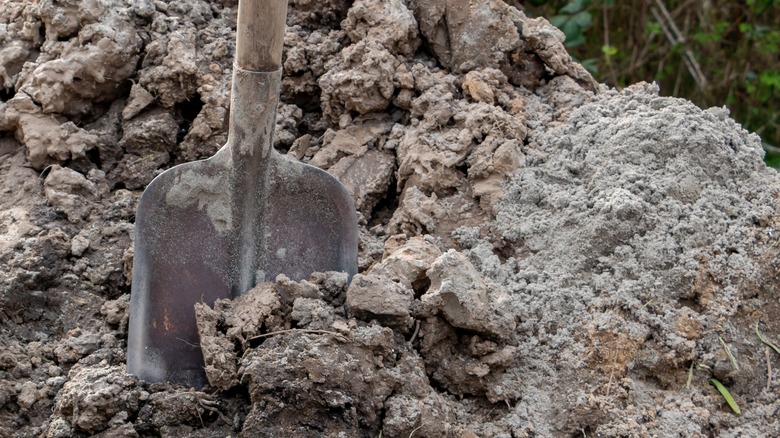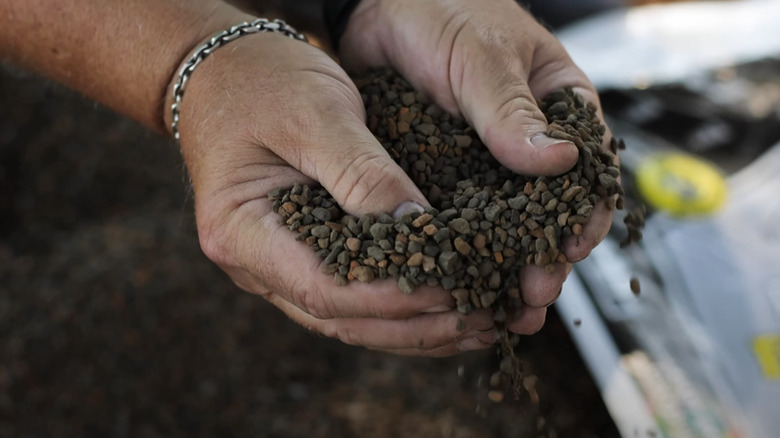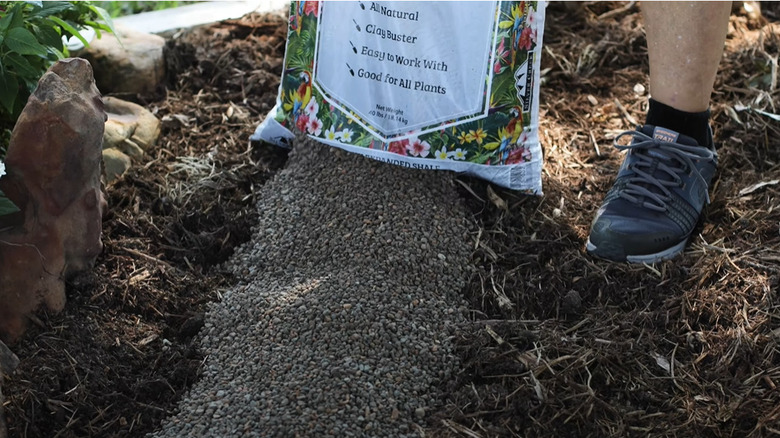The Simple Amendment That Will Improve The Heavy Clay Soil In Your Garden
Imagine the despair of finding your garden soil resembles a sticky mess more suited for a ceramics class than a patch brimming with greenery. If that strikes a chord with you, you know the woes of heavy clay soil that go far beyond its glue-like unworkable texture. Heavy clay soil also holds onto moisture, which turns your garden into a soggy, airless environment where plant roots gasp for breath. Luckily, your quest to improve heavy clay soil in your garden might be on the cusp of a victorious turn. The solution isn't settling for a landscaper that caters only to plants that grow best in clay soil like asters, rudbeckia, and hostas. Nor are we suggesting you spend a fortune to excavate your entire yard. The potential game changer comes in the form of expanded shale — an unassuming material that punches far above its weight when it comes to soil amendment.
Expanded shale, a lightweight particulate material, looks deceptively simple but could be a virtual miracle worker for the clay problems in your garden. It's essentially shale — the very same fine-grained sedimentary rock that lines lakes and river deltas and forms the bluffs– transformed by heat into a spongy agent of drainage and aeration. After it's fired to high temperatures in a kiln, shale emerges with a network of tiny holes, radically different from its beginnings. These cavities are the secret behind expanded shale's water drainage and retention capabilities, banishing the dreaded clay bowl effect from your garden and encouraging plant growth.
Expanded shale's benefits for heavy clay soil
With its rough, uneven shape and sturdy nature, expanded shale works its magic by creating microchannels within the dense clay soil. Therefore, your previously stubborn soil becomes less dense and easier to work with (for both gardeners and plant roots). But don't take these pores as just random cavities; they're vital airways that allow oxygen to penetrate deeper – that's the lifeline for healthy root development and beneficial soil microorganisms. The porous nature of expanded shale also steps up soil drainage, the dream scenario every gardener imagines when they're up against heavy, sticky clay. Boosted drainage slashes the nightmare of waterlogging and root rot, and your soil will warm up faster for an earlier start to planting.
Expanded shale soil conditioner has more tricks up its sleeve. Its pockets retain water like a sponge and release it slowly over time, so your plants enjoy a consistent moisture supply even during dry spells. That, of course, slashes the time you spend watering. And the cherry on top? This clay soil amendment does its deed without messing with your soil's balance. So, you don't have to worry about unwanted soil salinity and pH plot twists that could damage green companions. You'll also love that this soil conditioner is not just a short-term hack but a long-term ally. Unlike organic amendments that deteriorate over time, expanded shale's durability means that your soil will remain aerated, well-drained, and moisture-balanced for years to come.
How to use expanded shale for heavy clay soil in your garden
Wondering where to buy expanded shale? Sold in convenient bags at nurseries, garden centers, and soil suppliers, and readily available online, it's pretty straightforward to find. As for the cost, 40 pounds of Nature's Creation's expanded shale, rated for 1,000 square feet, will set you back $11.99 at Marshall Grain.
This soil amendment strategy begins with a 3-inch layer of expanded shale scattered across your green patch. Unyielding clay soil meets its match as you lean toward the higher end of this application for a complete transformation. With the aid of a garden rake, distribute the shale evenly. Then, using a tiller or garden fork, mix the shale pebbles into the top 6 to 8 inches of your clay soil. This action ensures the shale integrates fully into the stubborn clay soil, enhancing aeration, drainage, and retention in a manner a mere surface application cannot.
But the amendment doesn't stop here; Go ahead and cap that shale-laced base with a 3-inch layer of well-decayed compost. This introduces essential nutrients and beneficial microorganisms, creating a synergy with the expanded shale for a nutrient-rich, well-aerated, and well-draining growing medium for plants. You could even crown the amended soil with a 3-inch layer of mulch. Beyond heavy clay soil conditioner, expanded shale reveals its versatility in plant containers. Incorporating it in your potting mix at equal parts can improve drainage and moisture retention for healthier, more vibrant potted plants.


